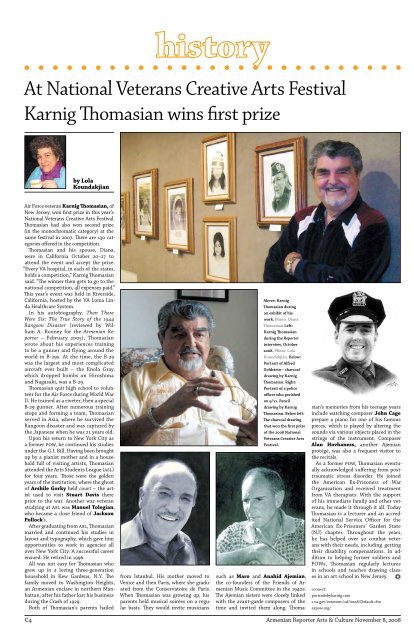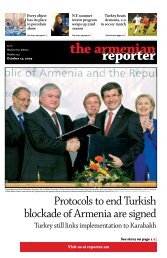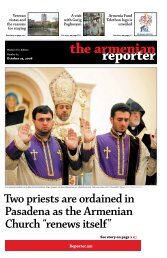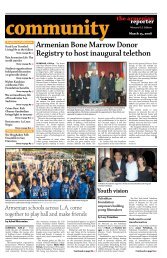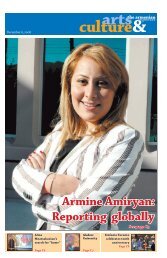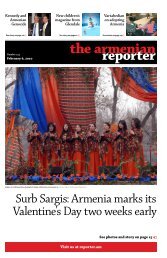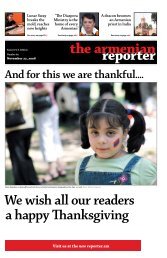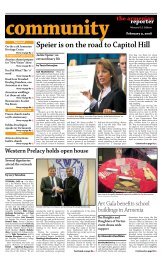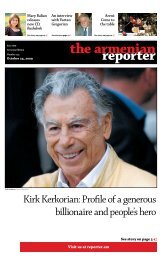You also want an ePaper? Increase the reach of your titles
YUMPU automatically turns print PDFs into web optimized ePapers that Google loves.
At National Veterans Creative Arts Festival<br />
Karnig Thomasian wins first prize<br />
by Lola<br />
Koundakjian<br />
Air Force veteran Karnig Thomasian, of<br />
New Jersey, won first prize in this year’s<br />
National Veterans Creative Arts Festival.<br />
Thomasian had also won second prize<br />
(in the monochromatic category) at the<br />
same festival in 2007. There are 130 categories<br />
offered in the competition.<br />
Thomasian and his spouse, Diana,<br />
were in California October 20–27 to<br />
attend the event and accept the prize.<br />
“Every VA hospital, in each of the states,<br />
holds a competition,” Karnig Thomasian<br />
said. “The winner then gets to go to the<br />
national competition, all expenses paid.”<br />
This year’s event was held in Riverside,<br />
California, hosted by the VA Loma Linda<br />
Healthcare System.<br />
In his autobiography, Then There<br />
Were Six: The True Story of the 1944<br />
Rangoon Disaster (reviewed by William<br />
A. Rooney for the <strong>Armenian</strong> <strong>Reporter</strong><br />
– February 2005), Thomasian<br />
wrote about his experiences training<br />
to be a gunner and flying around the<br />
world in B-29s. At the time, the B-29<br />
was the largest and most complicated<br />
aircraft ever built – the Enola Gray,<br />
which dropped bombs on Hiroshima<br />
and Nagasaki, was a B-29.<br />
Thomasian quit high school to volunteer<br />
for the Air Force during World War<br />
II. He trained as a riveter, then a special<br />
B-29 gunner. After numerous training<br />
stops and forming a team, Thomasian<br />
served in Asia, where he survived the<br />
Rangoon disaster and was captured by<br />
the Japanese when he was 21 years old.<br />
Upon his return to New York City as<br />
a former POW, he continued his studies<br />
under the G.I. Bill. Having been brought<br />
up by a pianist mother and in a household<br />
full of visiting artists, Thomasian<br />
attended the Arts Students League (ASL)<br />
for four years. Those were the golden<br />
years of the institution, where the ghost<br />
of Arshile Gorky held court – the artist<br />
used to visit Stuart Davis there<br />
prior to the war. Another war veteran<br />
studying at ASL was Manuel Tolegian,<br />
who became a close friend of Jackson<br />
Pollock’s.<br />
After graduating from ASL, Thomasian<br />
married and continued his studies in<br />
layout and typography, which gave him<br />
opportunities to work in agencies all<br />
over New York City. A successful career<br />
ensued. He retired in 1996.<br />
All was not easy for Thomasian who<br />
grew up in a loving three-generation<br />
household in Kew Gardens, N.Y. The<br />
family moved to Washington Heights,<br />
an <strong>Armenian</strong> enclave in northern Manhattan,<br />
after his father lost his business<br />
during the Crash of 1929.<br />
Both of Thomasian’s parents hailed<br />
from Istanbul. His mother moved to<br />
Venice and then Paris, where she graduated<br />
from the Conservatoire de Paris.<br />
When Thomasian was growing up, his<br />
parents held musical soirées on a regular<br />
basis. They would invite musicians<br />
Above: Karnig<br />
Thomasian during<br />
an exhibit of his<br />
work. Photo: Diana<br />
Thomasian.Left:<br />
Karnig Thomasian<br />
during the <strong>Reporter</strong><br />
interview, October<br />
2008. Photo: Lola<br />
Koundakjian. Below:<br />
Portrait of Alfred<br />
Goldstein – charcoal<br />
drawing by Karnig<br />
Thomasian. Right:<br />
Portrait of a police<br />
officer who perished<br />
on 9/11. Pencil<br />
drawing by Karnig<br />
Thomasian. Below left:<br />
The charcoal drawing<br />
that won the first prize<br />
of the 2008 National<br />
Veterans Creative Arts<br />
Festival.<br />
such as Maro and Anahid Ajemian,<br />
the co-founders of the Friends of <strong>Armenian</strong><br />
Music Committee in the 1940s.<br />
The Ajemian sisters were closely linked<br />
with the avant-garde composers of the<br />
time and invited them along. Thoma-<br />
sian’s memories from his teenage years<br />
include watching composer John Cage<br />
prepare a piano for one of his famous<br />
pieces, which is played by altering the<br />
sounds via various objects placed in the<br />
strings of the instrument. Composer<br />
Alan Hovhaness, another Ajemian<br />
protégé, was also a frequent visitor to<br />
the recitals.<br />
As a former POW, Thomasian eventually<br />
acknowledged suffering from posttraumatic<br />
stress disorder. He joined<br />
the American Ex-Prisoners of War<br />
Organization and received treatment<br />
from VA therapists. With the support<br />
of his immediate family and other veterans,<br />
he made it through it all. Today<br />
Thomasian is a lecturer and an accredited<br />
National Service Officer for the<br />
American Ex-Prisoners’ Garden State<br />
(NJ) chapter. Throughout the years,<br />
he has helped over 50 combat veterans<br />
with their needs, including getting<br />
their disability compensations. In addition<br />
to helping former soldiers and<br />
POWs, Thomasian regularly lectures<br />
in schools and teaches drawing classes<br />
in an art school in New Jersey. f<br />
connect:<br />
portraitsbykarnig.com<br />
1.va.gov/vetevent/caf/2008/Default.cfm<br />
axpow.org/<br />
C4 <strong>Armenian</strong> <strong>Reporter</strong> Arts & Culture November 8, 2008


